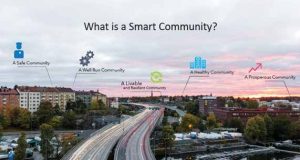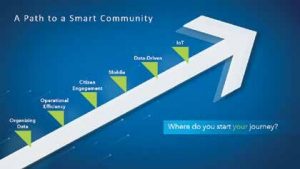Smart Cities: Putting a ‘Smart Communities’ Strategy to Work

The term “smart cities” has been around for a while now. You can’t go to an event or pick up a magazine without some discussion on smart cities, and a lot of organizations have jumped onboard and created “smart” projects and initiatives. But in the end, they’re a random set of workflows that aren’t connected. What’s lacking is a comprehensive plan that outlines overall objectives, sets milestones to get there and digitally transforms an organization.
This idea has exposed what I believe to be a missing element of the smart cities movement. Most smart communities describe a vision of the future or using technology to achieve a digital transformation. But what are you transforming? Or cities are using the Internet of Things (IoT) to keep connected, but connected to what?
It shouldn’t be about technology for technology’s sake; it’s about achieving the goals your community sets for itself and looking at the obstacles that are stopping it from achieving these goals. If your goal is to be the healthiest community, what’s stopping you? Is it a lack of parks, bike lanes, access to healthy foods or healthcare, or something else?
Outlining Key Goals
I see a pattern of governments identifying one or more of the common objectives in the accompanying figure on a “Smart Community.” If the goal is to be more resilient, it must mean it hasn’t achieved resiliency. So how do you develop an inventory of what and where your gaps are, and how do you apply new processes and technology to meet that goal?
At the 2017 Esri User Conference, leaders from India, Singapore and Dubai described their approaches to building a smart community. A stand out was Dubai, which described the purpose of its smart city to become the “Happiest City on Earth.” Representatives even extended this mission to a colony on Mars (not joking). Their “smart approach” was to overcome issues that hindered them from achieving this designation, acknowledging they needed a balance of people, policy, benchmarks and technology.

Path to a Smart Community
There are six foundational pillars governments need to provide to build a smart community:
1. Organize your data. Every time you approach a project, data need to be organized and ready. With open data, governments can take an inward- as well as outward-looking approach to sharing data.
2. Improve operational efficiency. Workflows such as inspections still are tied to clipboards and paper, which is a far cry from digital transformation. Governments should look at essential functions that still haven’t adapted or leveraged the latest technology. Transforming workflows will result in increased productivity and communication to the back office in real time.

3. Improve civic engagement. Governments should work to get the public involved in providing feedback (i.e., crowdsource applications), openly communicate what’s going on around the community (i.e., through story maps), and have apps ready when citizens ask for them or the community needs them (i.e., road closure, pothole reporter or government services apps).
4. Develop a “Mobile First” mindset. Keep in mind that employees and citizens turn to smart devices first. How can governments capitalize on this trend? Are you collecting, reporting and sharing information in a format they will embrace?
5. Provide tools for data-driven decisions. There’s a rise of data scientists and chief data officers as well as a shift in the way departmental analysts do their work. Having business intelligence tools and dashboards at the ready will help stakeholders make more informed decisions in real time.
6. Set up the infrastructure for IoT. Governments need to consider retrofitting their community infrastructure to be able to consume IoT, and technology needs to be put in place to allow for the consumption and analysis of sensor data across disciplines (i.e., air quality, traffic, mobile devices).
Learn more about how your organization can leverage technology to build a smart community at esri.com/smartcommunities.
About Christopher Thomas
Christopher Thomas directs government marketing operations at Esri; email: [email protected].


